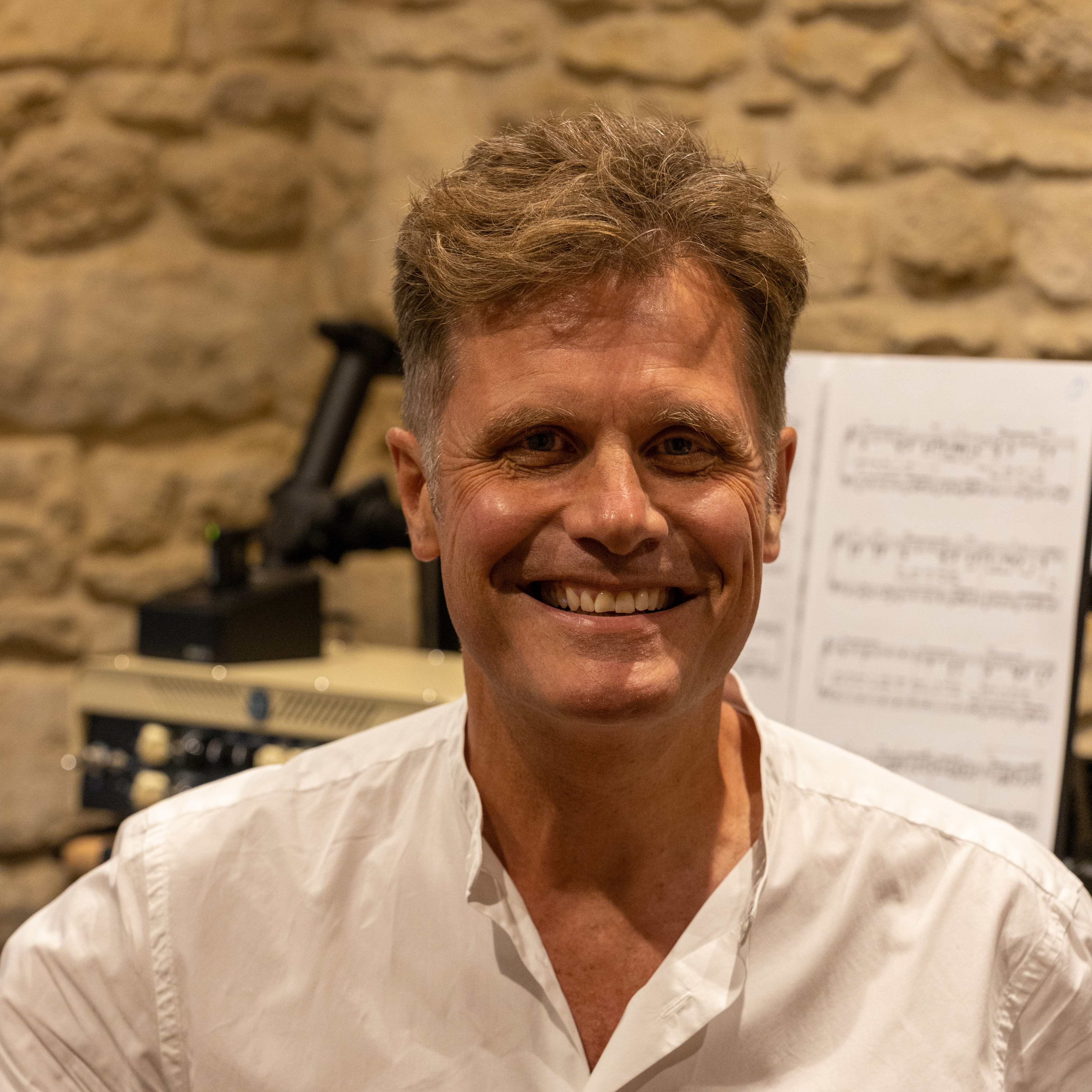Best beginner synthesizers 2025: Our pick of the finest synths for new players
Create huge cinematic sounds, driving basslines, ethereal pads, and expressive leads with synths from Roland, Yamaha, Korg, Sequential, Moog, and more…
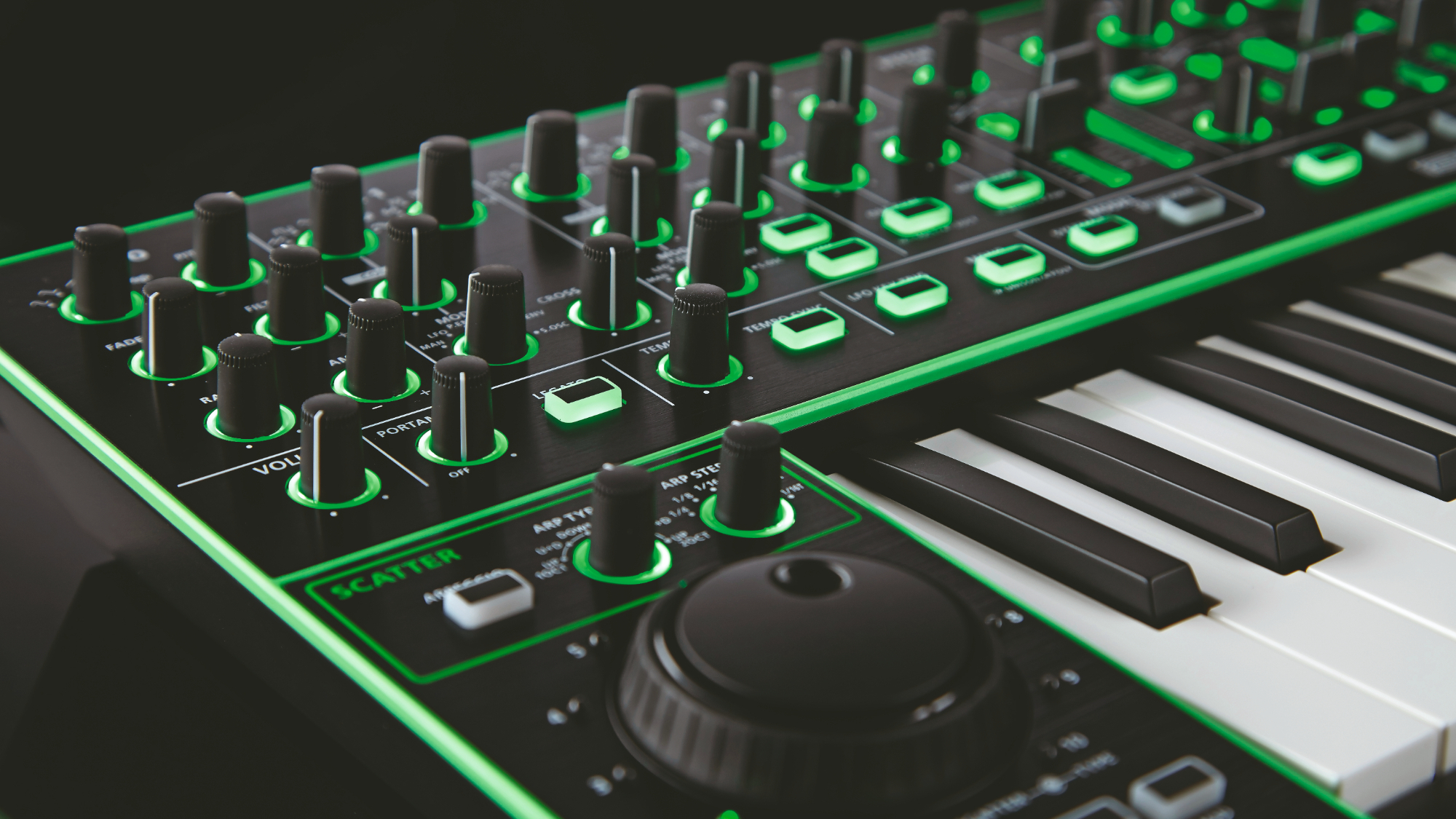
We don't blame you for wanting to buy one of the best beginner synthesizers. After all, is there any musical genre the synth hasn't touched in the past 60 years? It's hard to imagine life without their punchy basslines, ethereal pads and soaring leads.
After all, where's the fun in life without a chugging sequencer? Indeed, what is life without a Hi-NRG disco song or a hypnotic techno track enriching our evenings? And, how would we chill without some soft, calming ambient tones? Synths cover all the basses, not least, ahem, the bass.
The problem is they look so, well, complicated, particularly if you're a total beginner. All those buttons, dials, knobs, switches and flashing coloured lights – what if I don't speak nerd?
But you don't need to be intimidated by the apparent complexity to get started. It's actually very easy to learn the basics of synthesis, so whatever your chosen genre you'll be producing musical sounds within no time. It'll only take you about 15 minutes or less to sculpt your very own first patch, and you can always rely on the presets.
Secondly, you'll learn to love all those knobs and dials. Playing a synth is all about making constant adjustments to your sound, weaving in changes to make it evolve over time. It's one of the most expressive instruments you can get your hands on, so what's stopping you?
Ready to get started? Take you pick from our list of the best beginner synths and get knob twisting! We've got some useful buying advice further down the page if you want to learn more, too.
Best beginner synthesizers: Our top picks
If this were an awards ceremony, right about now as we break open the big gold envelope we'd be waffling on about the quality of the entries, how difficult it has been to decide on a winner and so on.
So, first some honourable mentions. The brand-new Sequential Take 5 is perfect if you're set on that iconic Dave Smith sound and the prestigious brand name. It's a similar story for the Moog Grandmother. Yamaha's Reface CS is a serious contender too, a fantastic beginner-friendly synth that's big enough to get your fingers around but small enough to take anywhere.
But there can only be one winner (OK, two). Korg's Volca Keys is a real blast for next to no outlay, and that's its true USP. What it lacks in features, it makes up for in character and the opportunities it gives you to have fun. Which is the whole point of making music. Want even more fun? Then link it up with other Volca models and really get your groove on. It's the biggest bang for your buck here.
At the other end of the price scale there's serious competition from the big brands, not least those mentioned above. Roland's venerable System 8 wins the day though. Its plugouts – Jupiter-8, Juno-106, JX-3P, SH-101 etc – let you bask in the warm glow of '80s nostalgia, yet its astounding internal sound engine is a modern classic. Nothing here matches it for versatility.
More than that, it's just so well designed and so intuitive to use, especially for beginners. We just hope you like the colour green.
Best beginner synthesizers: Product guide
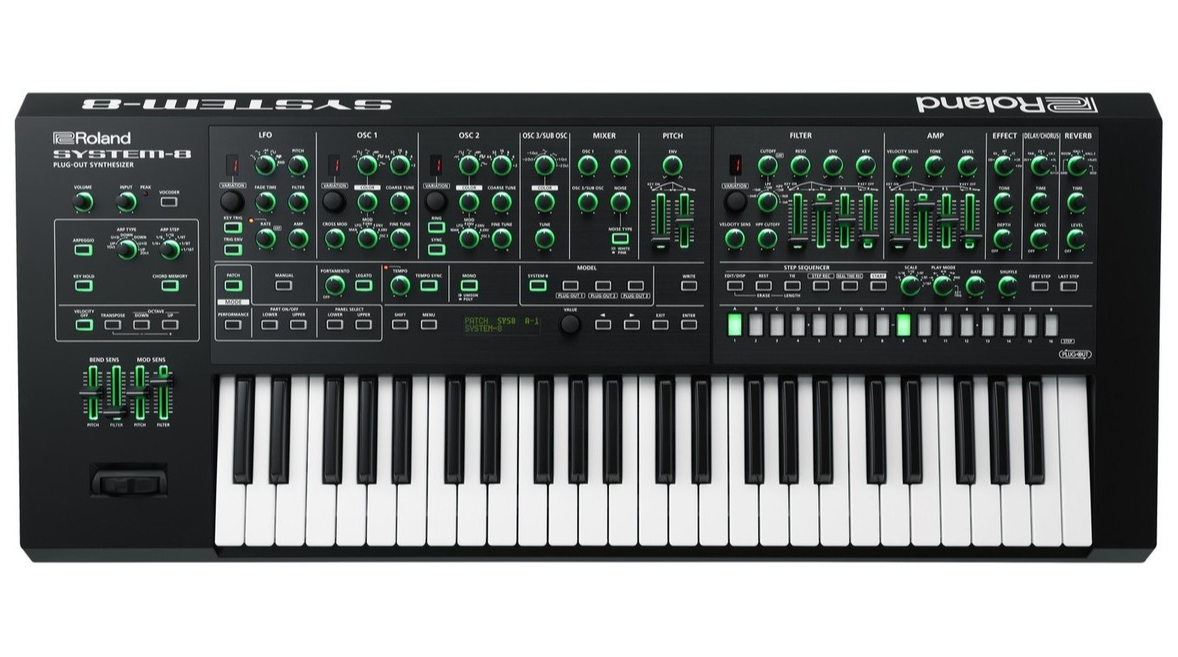
Specifications
Reasons to buy
Reasons to avoid
It may be greener than a seasick Kermit on a cross-channel ferry in a Force 10 gale, and as plasticky as inflight cutlery, but the System 8 is one of the best synthesizers around. In fact, thanks to Roland's 'Plug-out' architecture, it's actually four synths in one.
There's the System 8 engine, plus three additional expansion 'slots' to host models of Roland classics such as the included Jupiter-8, Juno-106 and JX-3P. A growing library of other models are waiting to be downloaded from Roland Cloud too, such as the manic PROMARS and basstastic SH-101, and all have matching plugins for your DAW.
When Roland, ahem, greenlighted the System 8 back in 2016, internet forums lit up with dull posts bemoaning the fact it wasn't analog and endless debates arguing over how accurate the modelled sounds were. The truth is the plug-outs sound uncannily like the originals, almost exactly the same but in tune (there's even a condition setting that, if you so wish, remedies this by making it sound old and flaky).
Since then, musicians have begun to appreciate that there's much more to this synth than excellent recreations from Roland's back catalogue. The System 8 engine is an absolute stonker, a future classic in the making. It can do dark and menacing, it can be a brash bass demon, it can excite with soaring leads or calm with tender ambient textures.
All this is possible because the System 8 boasts multiple flavours of analog-style and digital oscillators, including FM. Then there's cross-modulation, side-band filters, a vocoder, an arpeggiator, a powerful sequencer and a handful of very useable effects.
As a newbie, you're probably thinking all this sounds a bit complicated for a beginner synth. You may also be looking at the front panel and, once your eyes have become accustomed to the green glow, thinking 'that's rather a lot of knobs and sliders'. Well, don't worry, this is an amazing synth to learn on.
The top panel may look crowded, but it is an absolute joy. The signal flow – the steps needed to build your sound – is laid out in a super-intuitive manner. You just have to follow the panel from left to right, knob-twiddling and slider sliding as you go. Why are there so many knobs and sliders? Well, there's no awkward menu diving with the System 8, everything's there in front of you. Which means it's fun to use and quick to learn.
Read the full Roland System 8 review
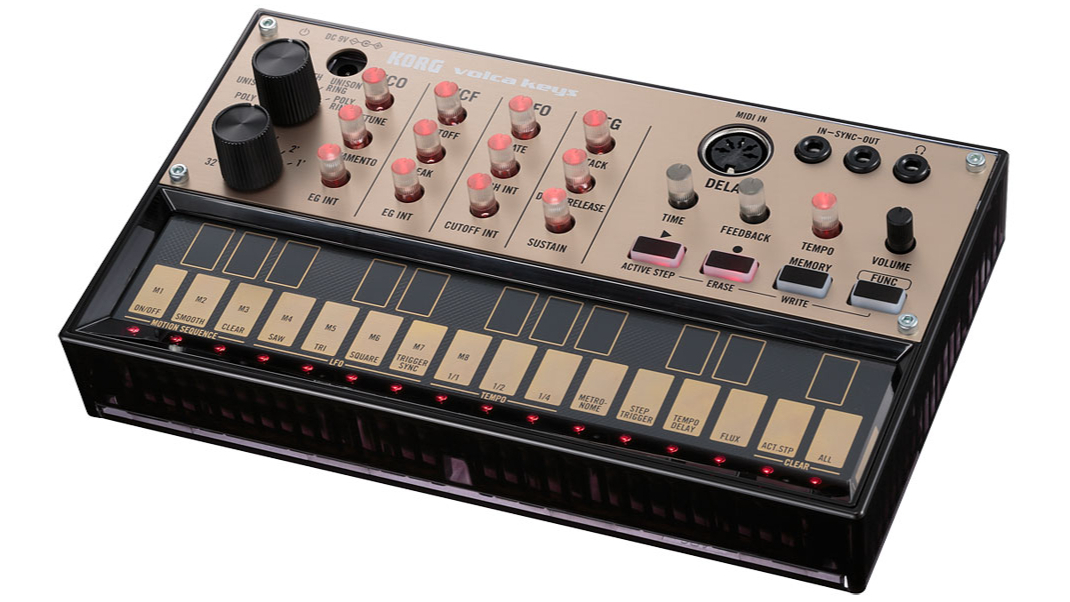
Specifications
Reasons to buy
Reasons to avoid
Korg's Volca series has been around for almost a decade now, and in that time has been responsible for introducing thousands to the delights of unbridled knob twiddling. If you're looking for battery-operated bliss, in the privacy of your own home or in public with other like-minded souls, then a Volca should jump to the top of your beginner synthesizer shopping list.
It's as much an ecosystem as it is a series. Currently seven little units – Volca Keys, Volca FM, Volca Bass, Volca Beats, Volca Kick, Volca Modular, Volca Nubass, Volca Sample, Volca Mix – that sound great on their own but are on another level when chained together. Here, we're concerned with the Volca Keys, but all are worthy of your attention.
The Volca Keys is a tiny, polyphonic analog synth with 27 ribbon keys and a loop sequencer. Not surprisingly, it's not the most fully-featured synth out there, nor is it the most comprehensive sound design instrument available today. Instead, it's an incredibly entertaining, inexpensive way to get into synthesis.
If it was a one-trick preset box, we'd probably discard it as a toy but fortunately the Volca keys follows standard subtractive synthesis convention and allows for plenty of hands-on control.
Getting to grips with the basics is simplicity itself. Twist the large voicing dial to choose how you want the Volca's three oscillators to be combined: Poly, Unison, Fifth, Unison Ring or Poly Ring. This will establish whether they are played in unison, de-tuned by a certain interval, have ring modulation applied and so on. It's a neat way of benignly limiting your options without curtailing your creativity.
You can then fine-tune other parameters with the smaller VCO (oscillator), VCF (filter), LFO and EG (amp envelope) knobs. Sprinkle on a dash of delay to taste and your sound design recipe is complete. It's that simple.
Just sixteen steps can be recorded to the sequencer, which doesn't sound a lot until you begin to use the overdub and active step functions. Overdub does what it says on the tin, while active step enables you to skip steps during playback for surprise rhythmic changes so that your performance can be more dynamic, less stale.
The Volca Keys sounds quite magnificent too, much bigger than its tiny form factor and insignificant price could ever suggest. Will you soon tire of it? On its own, it has its limitations, so the answer should be yes. But sync it up with a few of its siblings from the rest of the Volca family – Vocal Beats and Volca Bass for starters – and you've got a music making system that'll keep you fulfilled for years.
Read the full Korg Volca Keys review
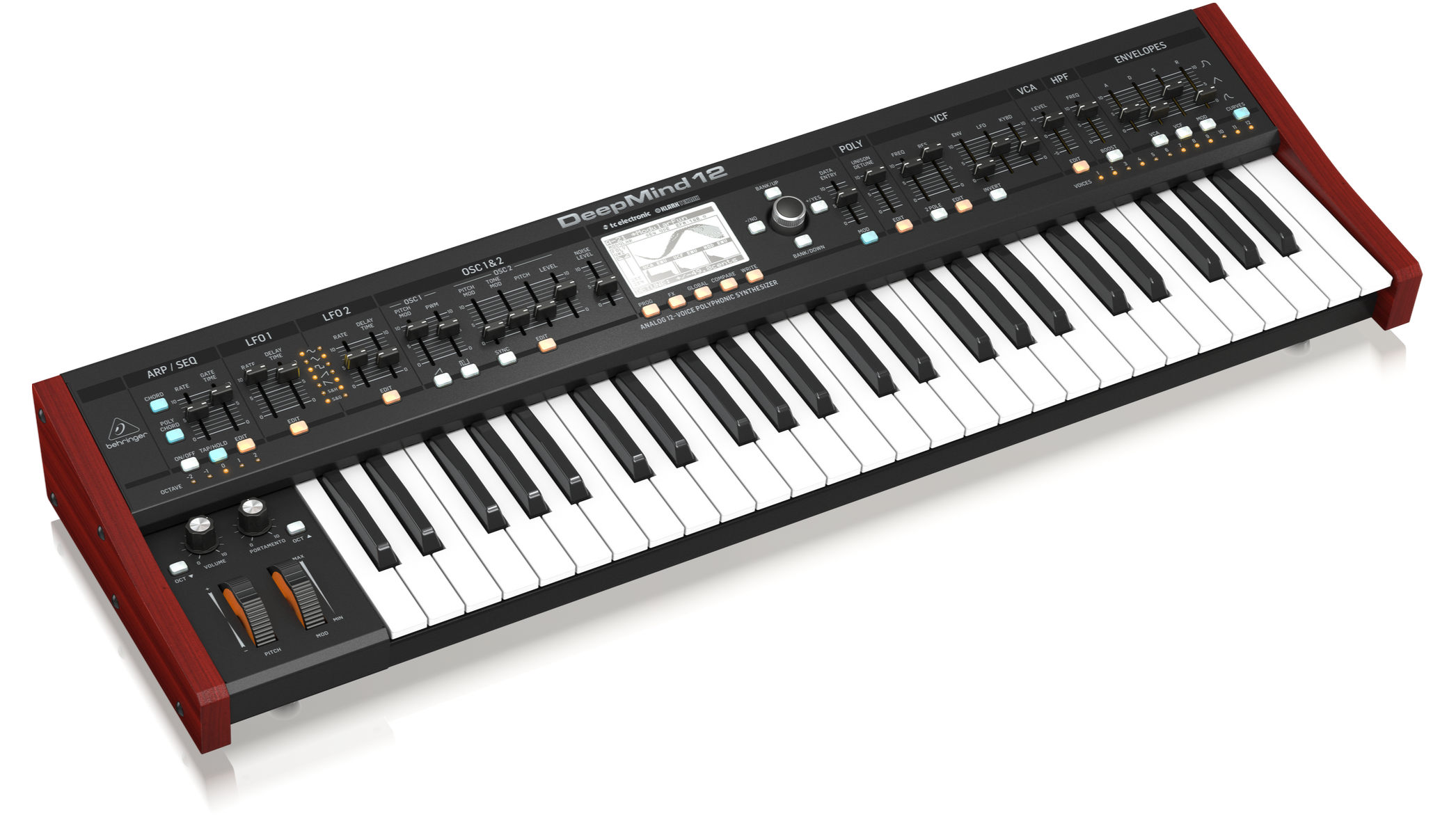
Specifications
Reasons to buy
Reasons to avoid
Behringer often gets a bad rap for being unimaginative at best and at worst, well, ripping off other brand's ideas and repackaging them as its own at bargain basement prices. The DeepMind 12 goes a long way to dispel the first criticism, while still retaining its reputation for good value.
This is an all-original synth (OK, with Juno 106 leanings) that boasts a vast feature set. For well-under $1,000/£1,000/€1,000 you get an analog 12-voice polyphonic synthesizer with four effects engines, two oscillators and LFOs per voice, a 32-step sequencer, tablet remote control and built-in WiFi. It promises a lot and delivers on most of it.
The polyphony is the headline feature here. Voices can be stacked in a variety of ways from simple doubling to building a 12-voice monophonic monster, but it is a shame that the Deepmind isn't multi-timbral. Still, it's capable of some lush multi-voice sounds that most other synths in this price range just can't get near.
Then there's the dedicated Mod Matrix, where 22 modulation sources can be routed to more than 100 destinations, an arpeggiator with configurable pattern modes, the all-singing, all-dancing sequencer and very deep MIDI implementation.
What's not to like? Adjusting either oscillator is a little fussy, due to their slightly quirky operation but it's something that you'll quickly get used to. More troubling for beginners is that many of the DeepMind's features and parameters can only be adjusted by menu-diving. The front panel is easy enough to follow, but it's far from comprehensive and the central mono screen is just too small for the amount of information that Behringer crams in.
Still, if you consider the sheer breadth and quality of sounds that the Deepmind 12 can deliver, Behringer has done a great job here. Build quality is surprisingly solid for the money and there's a 3-year warranty for peace of mind.
Read the full Behringer Deepmind review
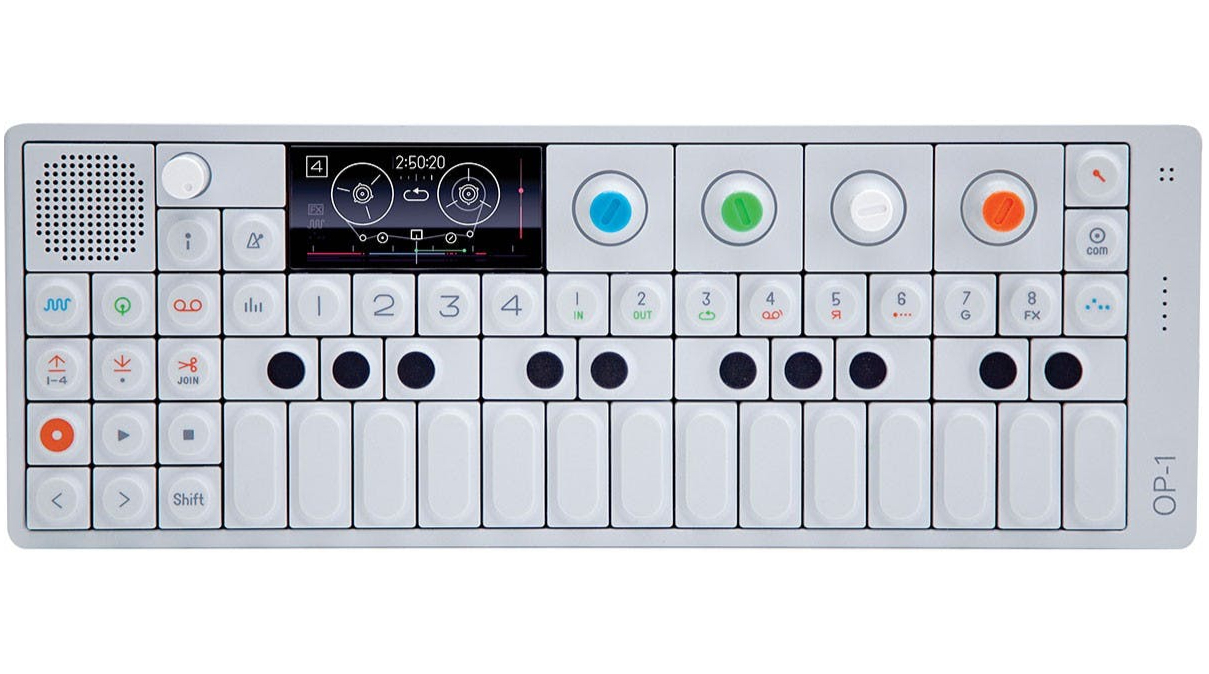
Specifications
Reasons to buy
Reasons to avoid
And now for something completely different. In many ways the OP1 isn't really the ideal instrument to learn synthesis on. There are just too many synth engines and too few immediate, hands-on controls. But a machine on which to learn to write and play synth and sample-based music? It's just fabulous.
The OP-1 is a portable synthesizer, sampler, 4-track recorder and controller. In short, it's a creative tour-de-force. Thirteen synth engines, seven quality effects and numerous routable LFOs are ready and waiting for lively experimentation. Chuck in a bucket load of samples, sequence the lot on the six – yes, count 'em – sequencers then record your masterpiece on the four-track virtual tape recorder. Overdub to your heart's content.
By limiting the OP-1's primary controls to just four brightly coloured encoders, the Swedish boffins at Teenage Engineering have developed a product that's fun, intuitive and non-technical to use. It's the old guiding principle of restricting complexity to maximise creativity.
You know what? That's selling the OP-1 a bit short because there're plenty of possibilities to explore here, it's just that the clever, if rather infantile-looking, interface never gets in the way. It looks like a toy but sounds like a pro-studio – one you can stuff in your back pocket.
Inspiring it may be, cheap it's not. Frustratingly, the OP-1 has almost doubled in price since its launch a decade ago, putting it beyond the reach of many. Teenage Engineering also has its pocket calculator inspired Pocket Operator series, which sells for pretty much pocket money. But unless you're just looking to dip your toe into the deep, warm waters of synthesis, they're a bit limited.
Another option is its inexpensive Pocket Operator Modular kits, which are a great way to learn modular, but potentially perplexing for complete beginners.
Read the full Teenage Engineering OP-1 review
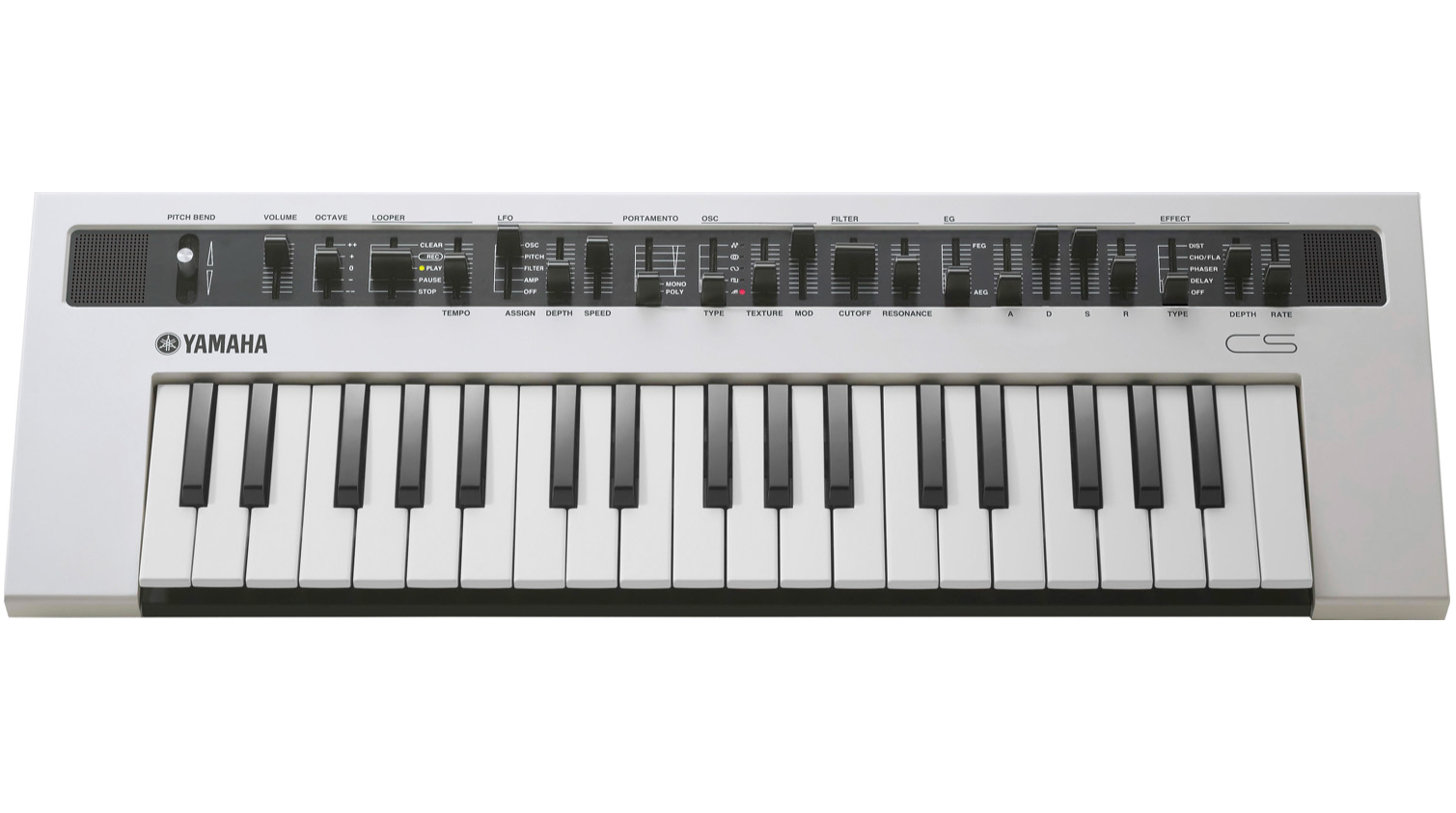
Specifications
Reasons to buy
Reasons to avoid
The Reface series plucks Yamaha keyboards from the past and re-imagines them as inexpensive, portable slabs fit for today's budget-conscious musicians on the move. They're a favourite with music students – they're a perfect fit in the lecture hall as well as halls of residence – and home-studio enthusiasts looking for a slice of yesterday flavoured Yamaha.
The Reface CS is inspired by Yamaha's famous Control Series that first popped up in the 1970s and was a favourite of artists as diverse as Vangelis, Michael Jackson and Brian Eno.
What made the original CS unusual was polyphony, the ability to play multiple notes, voices really, at the same time. Most synths in the 70s, such as Moog's ground-breaking Model D, were monophonic, which meant you couldn't play true chords on them and smooth, expressive legato runs were limited.
True to the original, the Reface CS boasts eight voices, which is, ahem, noteworthy because although polyphony is now commonplace, at this price point most of its competition are still monophonic. Decades on, it's still a standout feature that elevates the CS to the next level.
Another lovely feature for beginners is the clear, easy-to-navigate panel, that's essentially a long row of sliders. You can select one of five oscillator types – Multi-saw, Pulse, Oscillator Sync, Ring Modulation and Frequency Modulation – before adjusting other parameters such as amp and filter envelopes, LFO and effects. The sliders are easy to adjust and give immediate visual feedback as to how your sound is shaping up, which is invaluable for noobs.
There's no menu diving and the feature-set is limited to what's needed to make musical sounds and little more, making sound design both fast and fun. Consequently, it's hard to conjure up anything but delicious, usable patches, which saves a lot of fruitless messing about for beginners. Sadly, there's no way to save patches directly to the Reface CS, which is an annoyance but at least you can save them to Yamaha's Soundmondo app even if it is a bit of a faff.
Like all Reface models, the keyboard is short at just three octaves. On the flipside, this is a synth you can take anywhere, play on your lap and stash away in a corner when not in use. Perfect, for tentative beginners with limited space but unlimited ambitions.
Read the full Yamaha Reface CS review
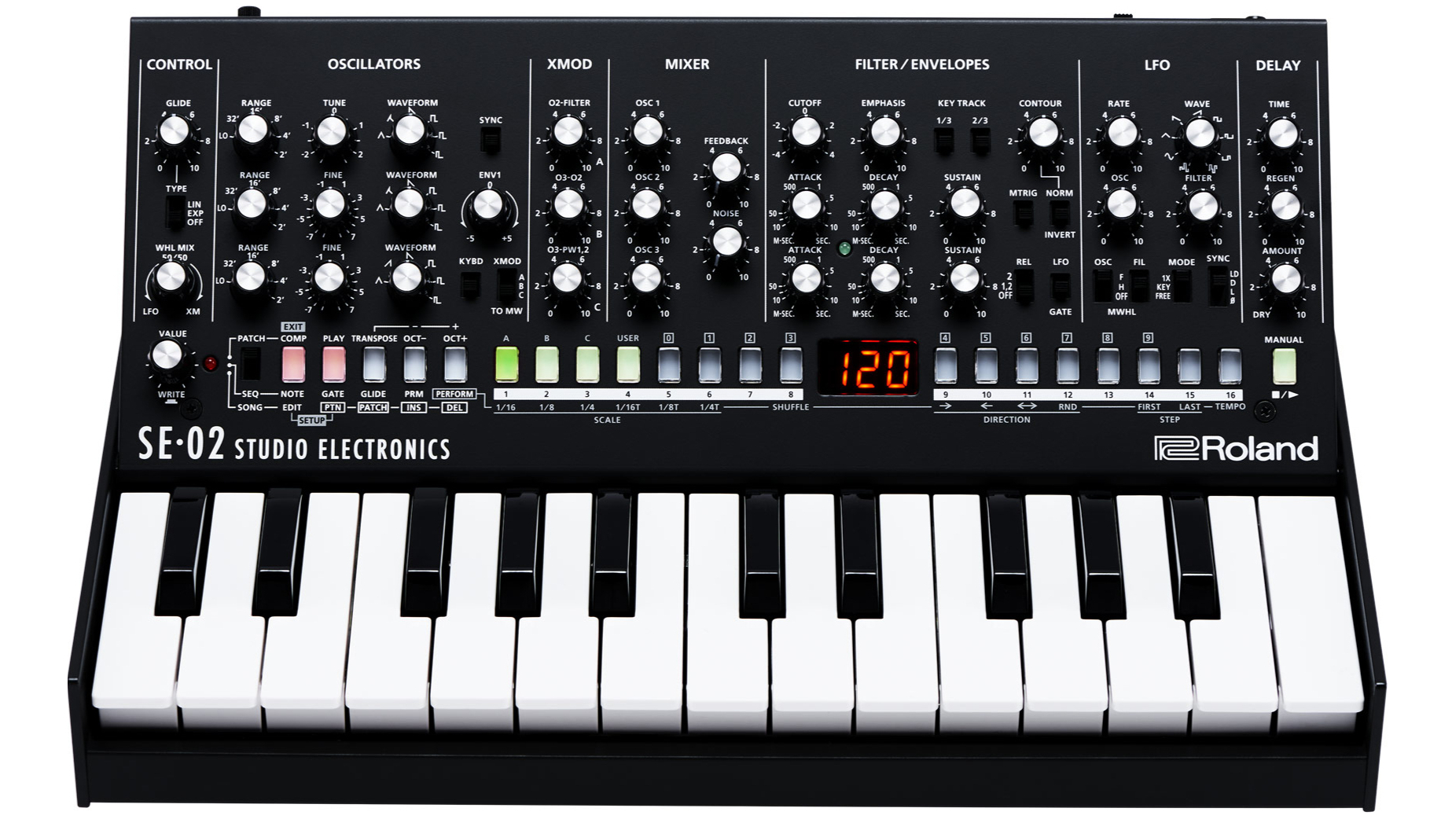
Specifications
Reasons to buy
Reasons to avoid
The SE-02 is part of Roland's Boutique range of diminutive synths that are, in the main, digitally modelled recreations of the brand's finest moments from the 1980s and 1990s.
This one's different though because it's analog and, somewhat bizarrely for Roland, based on a tweaked Moog Model D. Who saw that coming?
This tiny machine sounds enormous – a sonic whopper that properly surprises us every time we switch it on. It's monophonic but it has everything else you could want in a beginner synth package.
The front panel is fairly faithful to the original Model D, which is a good thing because Dr Moog got the ergonomics pretty much spot on back in the early 70s. Working from left to right you'll set up your oscillators before moving across to the mixer, filter and amp envelopes, LFO and delay. The obvious additions are the cross-modulation controls and the sequencer, which is an absolute gem.
It only stores 16 steps in a pattern, but it has a song mode which enables you to chain 16 of your patterns together. Composing a bass part, made up of several patterns, for an entire song is not only fabulously entertaining, it's a very worthwhile learning experience. Hit the start button and you and your mates can jam along, and/or you can trigger and advance the SE-02's sequencer with connected drum machines or other synths.
There's enough memory to store 16 songs, 128 patterns and 128 patches (plus 384 preset patches).
The SE-02 lends itself to basslines but it's no one-trick pony. Judicious detuning of the oscillators to thicken up the sound will take you into pad territory, and its various sawtooth waveforms are a fast shortcut to searing leads – a quick search on YouTube will reveal just how versatile this little machine is.
And, it is little. Very little, which means that the knobs can be hard to access if your parents cursed you with big, chubby fingers. Fine-tuning some of the settings can be problematic because twisting a small dial can provoke a big change, and it's easy to knock other settings while you're there.
Still, it's a very portable little beast, and we'd recommend buying the K-25m mini keys as a bundle. Like all mini keys they can be frustrating to use, but they do complete a minimalist portable setup.
If you can't stretch to the Roland SE-02 then consider Behringer's very similar Model D. It's quite a bit cheaper but its feature set is more limited – we think the SE-02's sequencer alone is worth the premium.
Read the full Roland Boutique SE-02 review
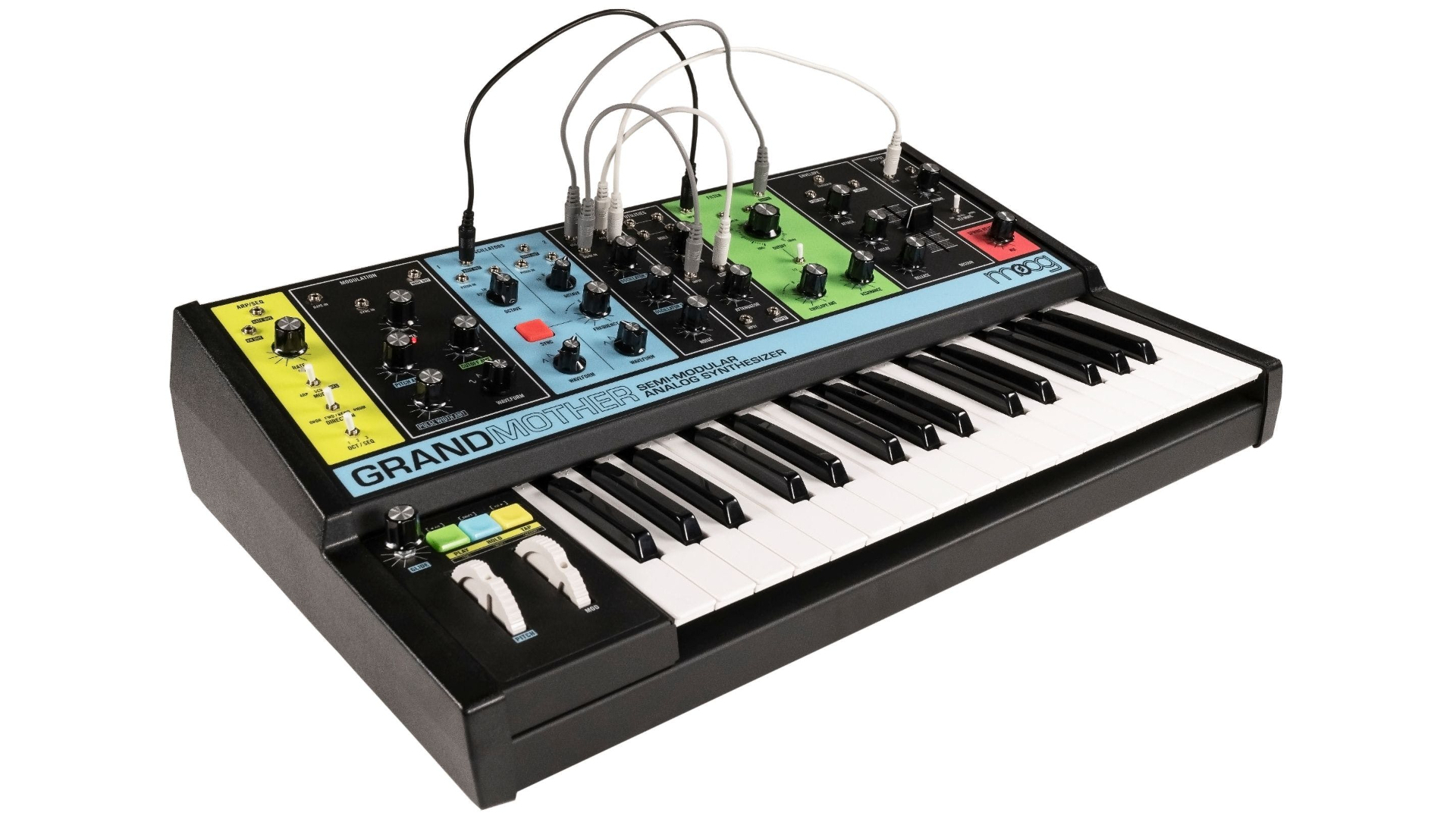
Specifications
Reasons to buy
Reasons to avoid
No doubt the Moog name (mooog, mogue, moch?) will be familiar to every beginner synth explorer, it's one of the most famous brands in music and many musicians still dream of owning a vintage 70s model, which have now reached stratospheric prices.
The company has gone through many changes over the years, and sadly its visionary founder Dr Bob Moog is no longer with us, but its products can still claim direct lineage with those classics from the 70s.
This is significant, because arguably Moog developed the first beginner synth. Before that, the company was producing a modular behemoth that cost an arm and a leg and was so complex few people other than Wendy Carlos really understood how to get anything musical from it.
Moog engineer Bill Hemsath noticed that despite the vast sonic choices that the company's modular synth offered, most musicians kept coming back to the same few simple components and routings – essentially a couple of oscillators, an LFO, a mixer plus amp and filter envelopes.
So, he built a much-simplified small wooden box that featured everything a non-technically minded musician would need and nothing else, its front panel laid out in a super-intuitive way. Moog named it the Model D, and it sold like hotcakes for the rest of the decade. It's no exaggeration to claim that it influenced the design of pretty much every non-modular synth since, including the Grandmother.
The curious name? It follows the Moog's recent maternal naming convention that tips a hat to the brand's vintage monosynths being the 'mother of all synths'. Current lines include the less expensive Mother-32 module and the feature-rich Matriarch.
Appropriately enough, this little synth retains the enduring Moog sound that we've all come to love. That character is largely defined by the oscillators and filter, which are based on the same circuits found in vintage Moog gear. It also preserves a similar, logical top panel layout, which makes it easy to navigate through the initially bewildering process of sound creation.
Where it differs is that the Grandmother is semi-modular, which means that the front panel can be reconfigured by patching the inputs of one section into the outputs of another and vice-versa. You can even patch external modules too, and build a system that rivals Moog's original modular synth for sonic complexity.
Yikes! Isn't that overkill for a beginner? Well, in some ways it goes against the elegant simplicity that was a of the hallmark of the Model D. But really it just augments that simplicity with choice.
Thankfully, you can learn and play the Grandmother without touching a patch cable, but that extra versatility will always be there when you're ready. This makes the Grandmother an ideal starting point to learn basic synthesis, before going on to master modular synthesis too.
In an effort to make learning even more accessible, Moog has colour-coded the various sections in bright yellow, blue, green and pink. After initial reservations (horror, tbh), this colour combination has grown on us, and we now think it looks rather cool in a retro Fisher-Price way. If you remain unconvinced, the Grandmother is also available in an all-black Dark Series version.
Read the full Moog Grandmother review
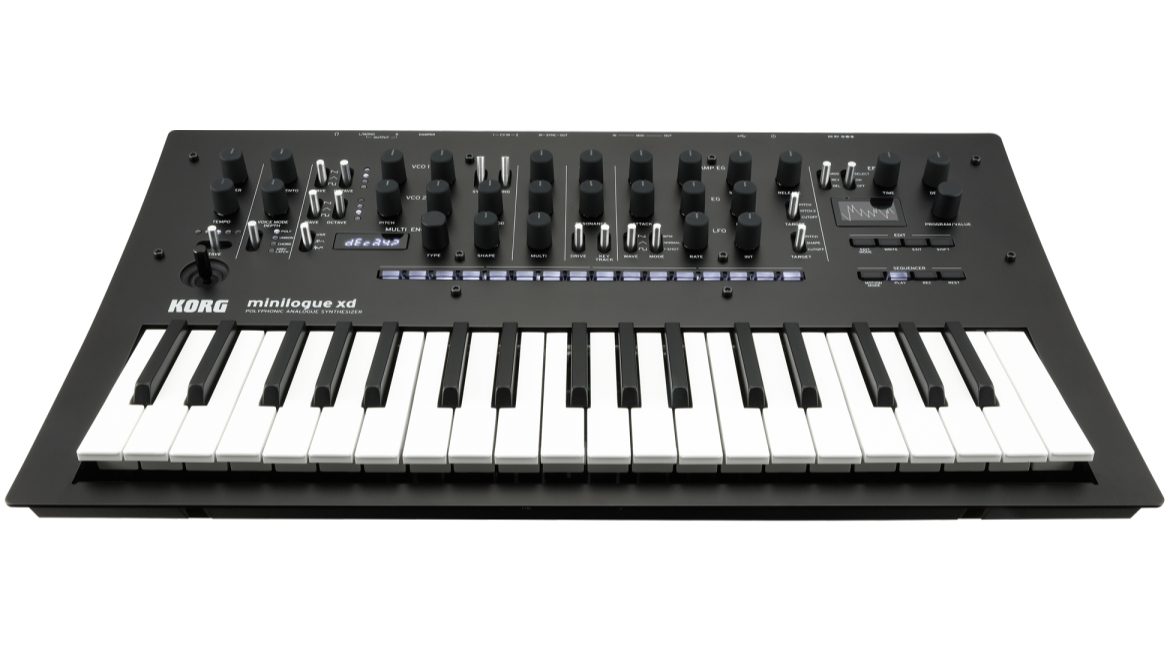
Specifications
Reasons to buy
Reasons to avoid
The Korg Minilogue XD has everything a beginner could need in a compact synth and then some. Essentially, Korg has taken the original Minilogue, which is also a fantastic starter synth, and shoehorned in a lot of the features from its flagship analog synth the Prologue.
Build quality is reassuringly robust. The metal case feels sturdy enough, as do the metal-shafted pots, and the classy wooden rear panel is a lovely touch. Like many Korg synths, the Minilogue XD features a SlimKey keybed, which doesn't get us leaping up and down with excitement, but it plays well enough and keeps the unit's size manageable.
All the usual controls can be found on the smart top panel. Two VCOs (oscillators), mixer, filter, an amp envelope generator, a second assignable envelope generator, LFO and a range of digital effects. There's a dedicated portamento control and a step sequencer that supports step recording, real time recording and motion recording.
Korg has done a great job with the top panel ergonomics on the Minilogue XD. It's a synth that's a joy to play fluidly without having to menu-dive every few seconds, always a creativity killer.
Like the original Minilogue the XD has four analog voices, which is half the number of the Prologue but then its less than half the cost. These can be voiced as standard poly, unison for stacked detuned notes, chord mode and arpeggiator mode, which includes 13 different types from manual to random.
So far, so good, but it gets better, much better. The XD has inherited the Prologue's Multi-engine, which is used in place of a third standard oscillator. This expands the XD's sound almost infinitely, adding a noise generator and custom engines including wavetable and FM. You can even develop and load your own custom oscillators into 16 user slots. Incredibly, the Multi-engine can be combined with the two analog oscillators for adventurous sound design possibilities that respect no boundaries.
OK, perhaps this is overkill for a beginner synth, but you won't remain a noob forever. The Minilogue XD is a synth that has the power to stoke your ambition for years to come.
Read the full Korg Minilogue XD review
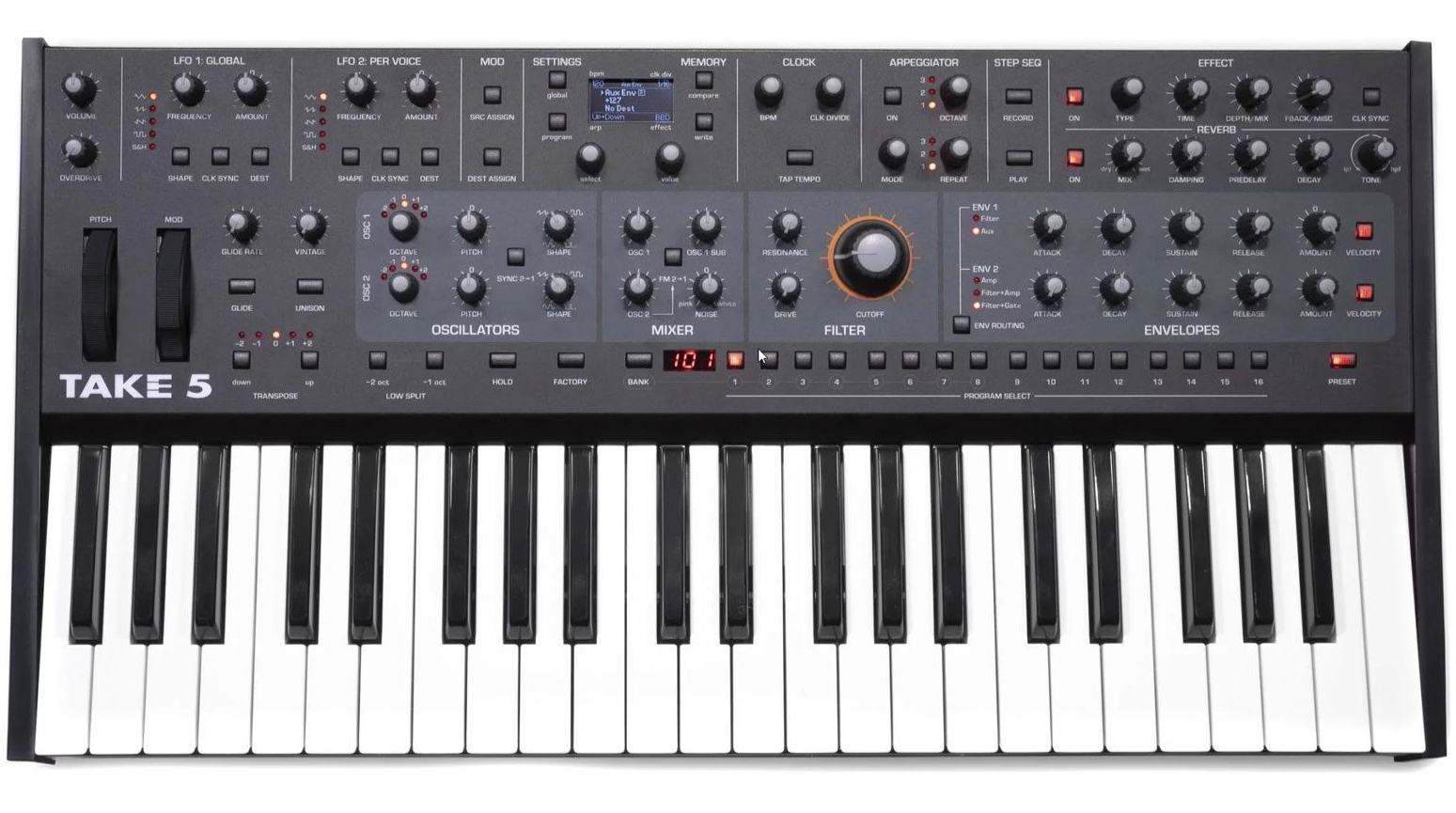
9. Sequential Take 5
Our expert review:
Specifications
Reasons to buy
Reasons to avoid
Like Moog, Sequential is a legendary brand famous for making very desirable analog synths that deservedly command premium prices. Since the 1970s, it too has enjoyed, and at times endured, a very convoluted history, including the recent acquisition by Focusrite, but thanks to the genius of founder Dave Smith it's still flourishing.
With many of its synths typically commanding prices of $1,700/£1,700/€1,700 and up, Dave wasn't known for making beginners' instruments. Until now.
The brand-new Take 5 has been specially developed for novices and gigging musicians who want that iconic Sequential sound in a compact, relatively affordable package. As Dave put's it: "Whether it’s your first synth, your gigging synth, or just the right synth to fit your studio space, we think you’re going to love it. Yes, it’s compact, but it’s pure Sequential and it sounds huge."
Dave's only partly right. At 25 inches (63.5cm) wide, it's not that compact. Manageable, yes but it's not compact like a Roland SE-02, an OP-1 or a Korg Volca. That's no bad thing though, because it leaves plenty of space for a 3.5 octave keyboard and a generous control panel.
It's not that cheap either. At $1,100/£1,100/€1,100 we imagine it's still at the top end of most beginners' budgets.
The control panel is beautifully thought out, with dials and buttons for almost everything, including a huge filter knob that takes pride of place just off centre. There's no call for menu-diving, everything's to hand.
As the name suggests, the Take 5 is a five-voice synth that gets its Sequential character from two analog oscillators and a sub oscillator passing through a Prophet-5 style four pole analog filter. A vintage knob adds further character by introducing parameter variations from one voice to the next – essentially it mimics the tuning instability inherent in 70s analog gear that provided additional depth and warmth. Modern circuitry can sound a bit sterile, so here you can dial some flaws back in!
You get two LFOs, one global and one per voice, two assignable envelopes, a quiver of digital effects, a gorgeously gritty overdrive plus continuously variable wave shaping and basic FM behaviour.
The 64-step sequencer is fairly basic, but it's very easy to use and provided you've left yourself with enough voices you can jam along with it.
There's nothing to dislike about the Take 5, quite the contrary. It's a beautifully thought-out synth at a price point rarely visited by Sequential. There are other synths out there that give you more features for less money, but none will have that characterful Sequential sound. If that's important to you then the Take 5 is a bit of a bargain.
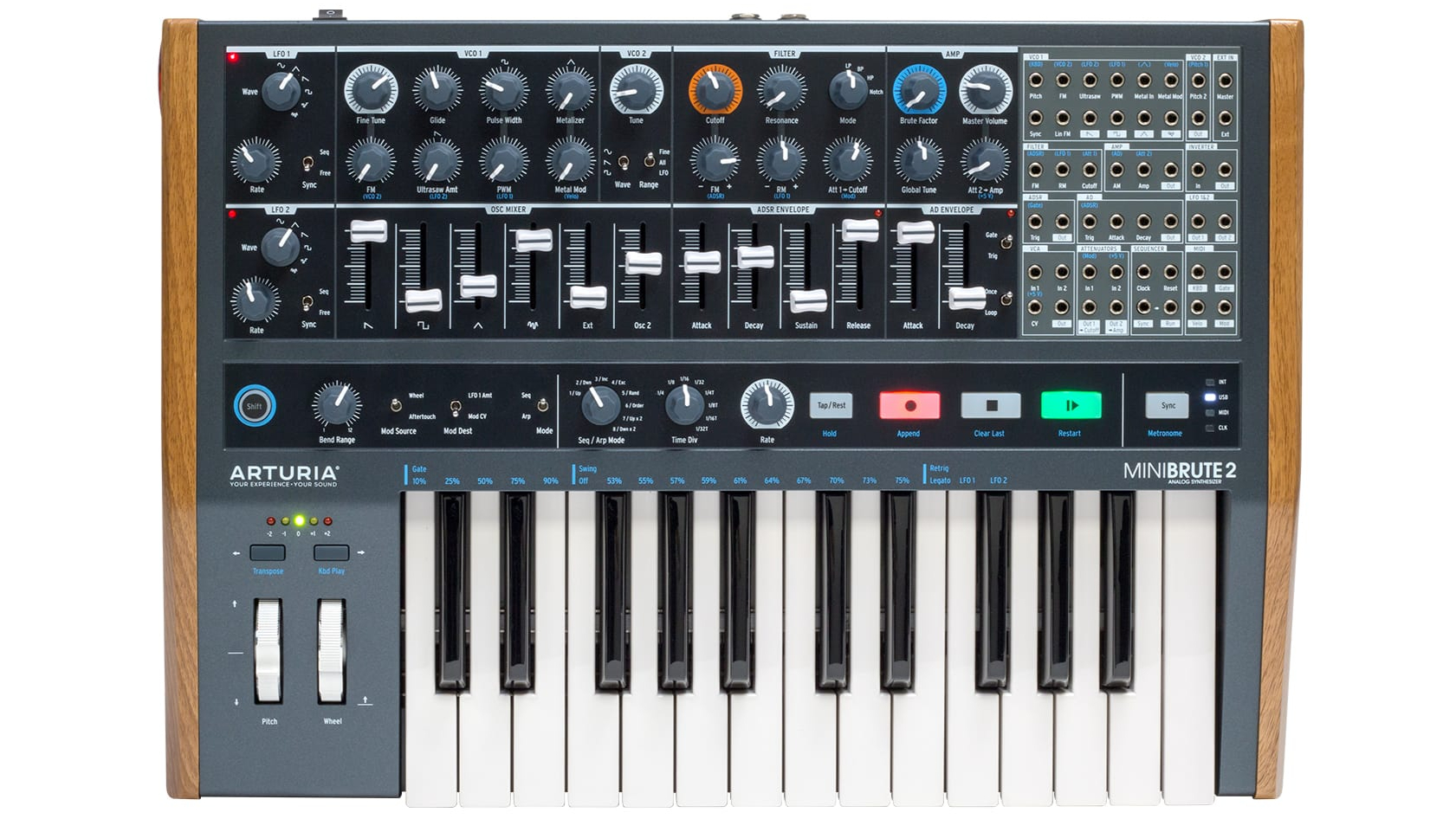
Specifications
Reasons to buy
Reasons to avoid
Hmm, is the Minibrute 2 really a synth suitable for beginners? If you look at the price, then we believe the Minibrute 2 qualifies. If you look at the features and the complexity of the top panel, that 48 CV patchbay in particular, then there has to be a caveat. The Minibrute 2 is an excellent synth for those looking for a gateway into the world of modular synthesis.
If you already know the basics, but modular is still an intriguing mystery to you, then the MiniBrute 2 could just be your first-class ticket to a new sonic universe worthy of exploration.
This is an unusual synth. Forgetting the patchbay for a minute, initially the top panel looks unremarkable enough. There are sections for two oscillators, mixer, filter, amp, envelopes and so on. But almost immediately it gets interesting because the primary oscillator's waveforms can be output simultaneously and blended via the mixer. The wave types also have a modifier control for more intricate shaping, there's the mayhem-inducing 'Brute Factor' drive knob and so it goes on.
Apparently, Arturia's goal with the Minibrute 2 is to enhance the sonic possibilities available to musicians, 'to sweep aside conventions and preconceptions in terms of what a synth should be'. Nobody can accuse them of pursuing this in a half-hearted manner!
Back to the patchbay and with skill, judgement and experience, or just good old-fashioned potluck, you can start to re-route this little synth's default signal flow for almost endless sound design opportunities. Once you've exhausted these possibilities you can connect it to other modular gear and continue to tinker, dabble and finesse.
It was always Arturia's intention that the Minibrute 2 would be the creative glue that bridged the gap between the traditional synth world and the modular scene. It sees this strange little synth as the catalyst that quite literally sits at the heart of your modular setup. Only you'll know when you're ready…
Read the full Arturia Minibrute 2 review
Best beginner synthesizers: Buying advice
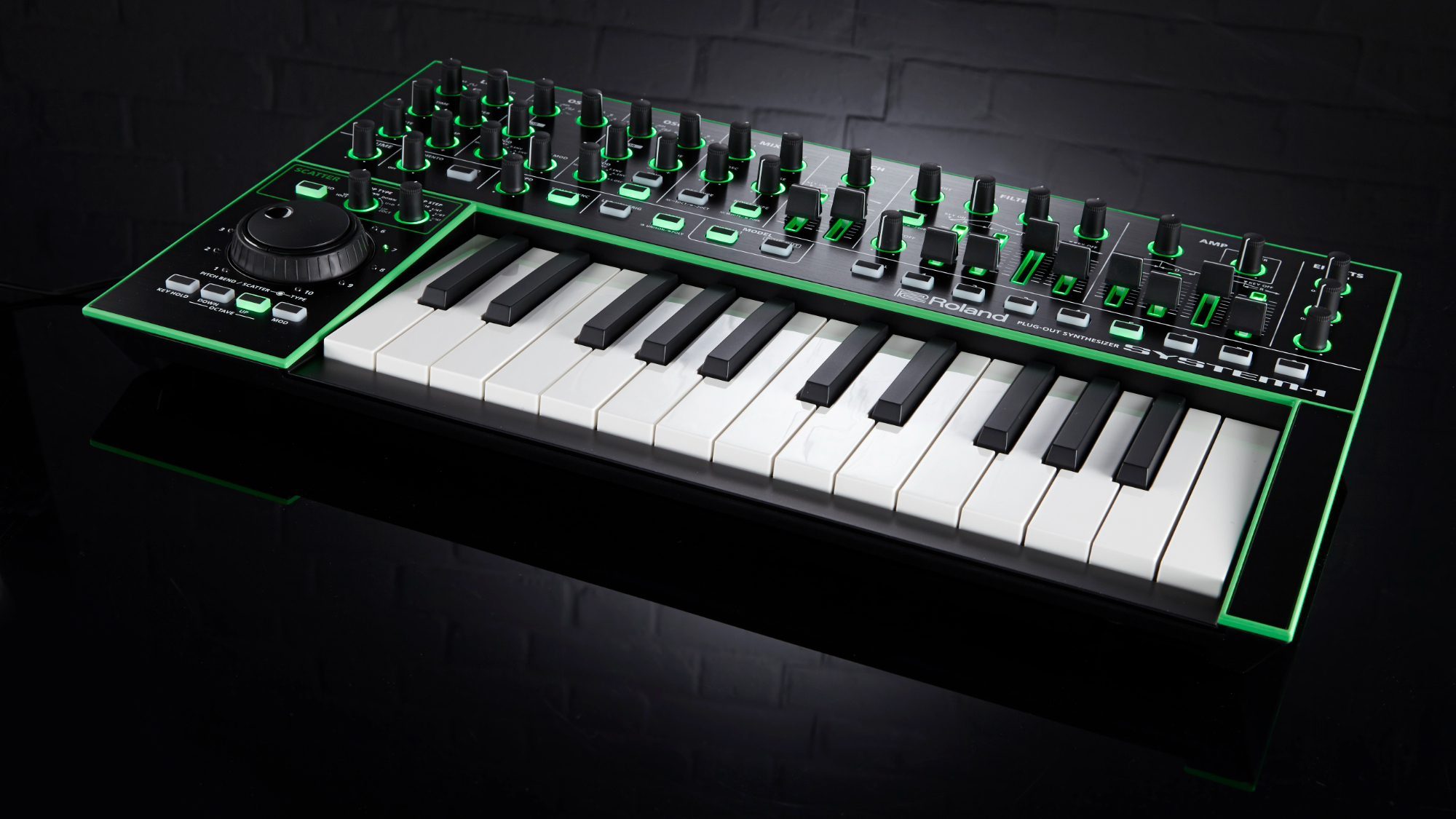
What to look for in the best beginner synthesizer
MusicRadar's got your back
Let's make some basic assumptions. First, you probably don't want to spend more than $1,500/£1,500/€1,500, hopefully significantly less. You do want to learn synthesis – the art of sculpting sound – but you'd like this process to be as fast, rewarding and as simple as possible.
You may be in a band that regularly gigs, but equally you may just want a synth for your home studio. Finally, you'd like your relationship with it to last well after you've lost your synth virginity – it's unlikely you'll stay loyal to your first synthetic love, but it should still excite you for years to come.
Synthesis can be very straightforward, but it can also get very complicated very quickly. You've probably heard of the various types of synthesis that exist including subtractive, additive, wavetable and FM. For example, some synths, such as the Korg opsix, are labelled as FM synths while others such as the Roland SE-02 are subtractive.
Ultimately, it's your choice, but we strongly recommend you start your learning experience on a subtractive synth. The process is very intuitive and knowing the basics will serve you well should you move on to the other types. The most complex one to learn is FM, but it does yield some gorgeous bell-like and metallic tones.
Analog vs digital synths
You may also have heard or read discussions about analog vs digital. In a nutshell, most subtractive synths are analog, or imitate analog behaviour, while wavetable, FM and additive tend to be digital. Very broadly speaking, analog synths ruled the 70s and early 80s before a digital wave swept them away in the mid-80s. In the past couple of decades there has been a resurgence of interest in analog synths that borders snobbery – just like valve amps vs digital in the guitar world. Some regard analog as warm and organic sounding, while digital is clean and clinical. In our opinion a decent synth – digital or analog – can cover the same ground equally well, but may be weighted one way or the other.
To complicate matters further, digital modelling is now so good that it can accurately imitate analog behaviour, giving rise to marketing phrases such as virtual analogue (Yamaha) and Analog Circuit Behaviour (Roland).
So, which is better? FM and analog sound so different it just boils down to your intention. Analog vs modelled analog? In our opinion it's almost impossible to tell the difference without looking at the price tag, which is usually higher for true analog. All of the synths in this guide are subtractive, but there's a mix of analog and digital analog modelling. They all sound good.

Subtractive explained
Subtractive synthesis works on the principle of a harmonically rich sound source being sculpted into a target sound by skilfully removing some of its harmonics. It's a bit like a statue hewn from a solid block of marble. Every chip of stone that's removed brings the sculptor closer to revealing a piece of art.
The harmonically rich sound source is generated by an oscillator, which in the analog world is often referred to as a voltage controlled oscillator or VCO because its frequency is controlled by a voltage input.
Oscillators produce simple waveforms such as square waves, triangles and sawtooths, each with different sonic characteristics. For example, a pure sine wave has no harmonics, which makes it sound smooth and mellow. A sawtooth has a large number of harmonics, so it's buzzy and aggressive, while a triangle wave falls somewhere between the two.
Many sounds can be made with a single oscillator, but most synths will combine two or more in a mixer to provide an even richer sound source. The more the merrier.
Every chip of stone that's removed brings the sculptor closer to revealing a piece of art.
After the source has been mixed, filters are employed to remove some of those harmonics to sculpt a sound's timbre – its tonal colour/quality. A lowpass filter can remove the high end and a high pass filter can remove the low end, while a resonance filter can be used to add emphasis or boost a narrow frequency range.
Filters can be modulated – changed over time – with an ADSR envelope. This controls the filter's attack, decay, sustain and release or, in other words, how quickly the filter opens, remains open and then closes.
Similarly, the sound's amplitude or volume is commonly modulated with an ADSR envelope too. Consider a plucked string. The onset of the note – the attack – is very sudden but the decay, sustain and release – the way in which the note dies off – happens more slowly. A bowed string also has a relatively long decay, sustain and release but it also has a much slower attack. The sound builds up more gradually as the bow is drawn across the string. These characteristics can be shaped with envelopes.
Most synths also feature at least one Low Frequency Oscillator or LFO as a modulator. This is an oscillator that operates very slowly, usually below the range of human hearing, but its wave shape can be used to modulate other parameters. For example, modulating the pitch of a sound by applying an LFO to an oscillator will produce a vibrato effect. Modulating the amplitude will produce a tremolo effect.
Lastly, many synths will have at least one effect, such as reverb, delay or chorus that can be applied to your sound to thicken it and give it more character. Of course, you can rely on outboard effects boxes to do this for you but that means more expense, more cables and more setup. Onboard effects are more convenient.
Ideally, you'll want to be able to access your synth's oscillators, mixer, filter, amp, envelopes, LFO and effects from the top panel, otherwise sound design quickly becomes a very long-winded, frustrating affair that involves lots of menu diving.
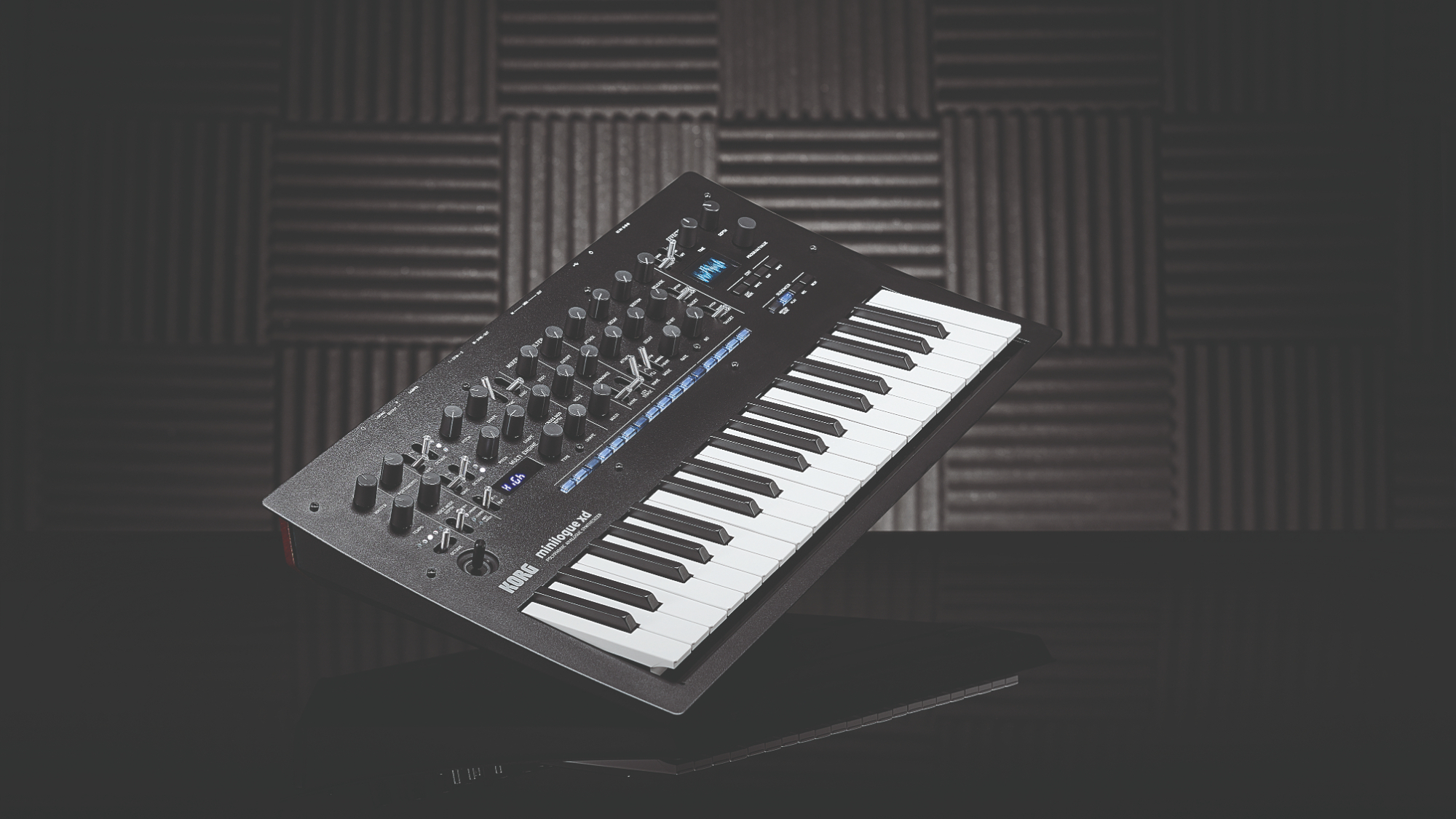
Synths are a hands-on instrument
Watch any good pianist and they'll be shaping sound by damping the notes with the pedals and striking the keys harder or more softly to reveal different dynamics throughout the piece. There's more to it than just hitting the right notes, but they're limited with the controls they have to hand and foot.
Synth players don't face such restrictions because they have a wealth of controls at their disposal, or at least they should have. When choosing a beginner synth don't be deterred by a top panel full of knobs, dials, sliders and buttons. In fact, seek out a synth with as many physical controls as possible, provided they're laid out in a logical order. When performing, the last thing you want to be thinking about is which hidden menu you need to access in order to change a simple parameter.
Just like the pianist, or any other musician for that matter, a good synth player will constantly be updating and adjusting parameters to bring movement and dynamics to a performance.
But how do you do this when your hands are busy tapping out a complex bassline? You use your synth's arpeggiator and sequencer, invaluable tools for the beginner and great fun to use.
An arpeggiator will play a series of notes, usually a chord, in a pre-determined sequence. A key hold button will continue to trigger the arpeggiator when you release the key. Sequencers have a similar role but can play more complex patterns and those patterns can sometimes be chained together to form a complete song.
Both enable you to remove your hands from the keyboard to play with the parameters on the top panel. Clearly, this is useful for performance, but it's also really handy when you're trying to design a new sound from scratch. Instead of hitting a key, altering a parameter, then hitting the key again to hear the effect, you can program the sequencer to play a pattern for you so that you can hear the changes in real time.
To recap, to make your life easier choose a synth with a comprehensive top panel, an arpeggiator and a sequencer.
Voices and timbrality
Polyphony governs the number of notes, or voices, that a synth can play at any one time. Monophonic synths can only play one note at a time, while polyphonic synths can play two or more. Traditionally, monophonic synths, like the Moog Model D, were expensive but polyphonic synths were ruinously expensive. Today, this still holds true in that an eight-voice synth will generally be more costly to buy than a four-voice synth.
Naturally, monophonic synths are a good choice for basslines and polyphonic synths are a better choice for legato runs and chords. However, multiple oscillator monophonic synths can still sound absolutely huge if their oscillators are detuned either slightly or in fifths and thirds to make chords. If your budget will stretch to it buy a synth with as many voices as possible, but if not you can still develop some incredible sounds with a single voice.
A multi-timbral synth will not only have multiple voices but it will be able to play more than one type of sound or timbre at the same time. So, a bass line and a lead line can be played simultaneously on a split keyboard. It's even possible to play a drum part, a bass line, a pad and a lead on a multi-timbral synth paired with a powerful sequencer.
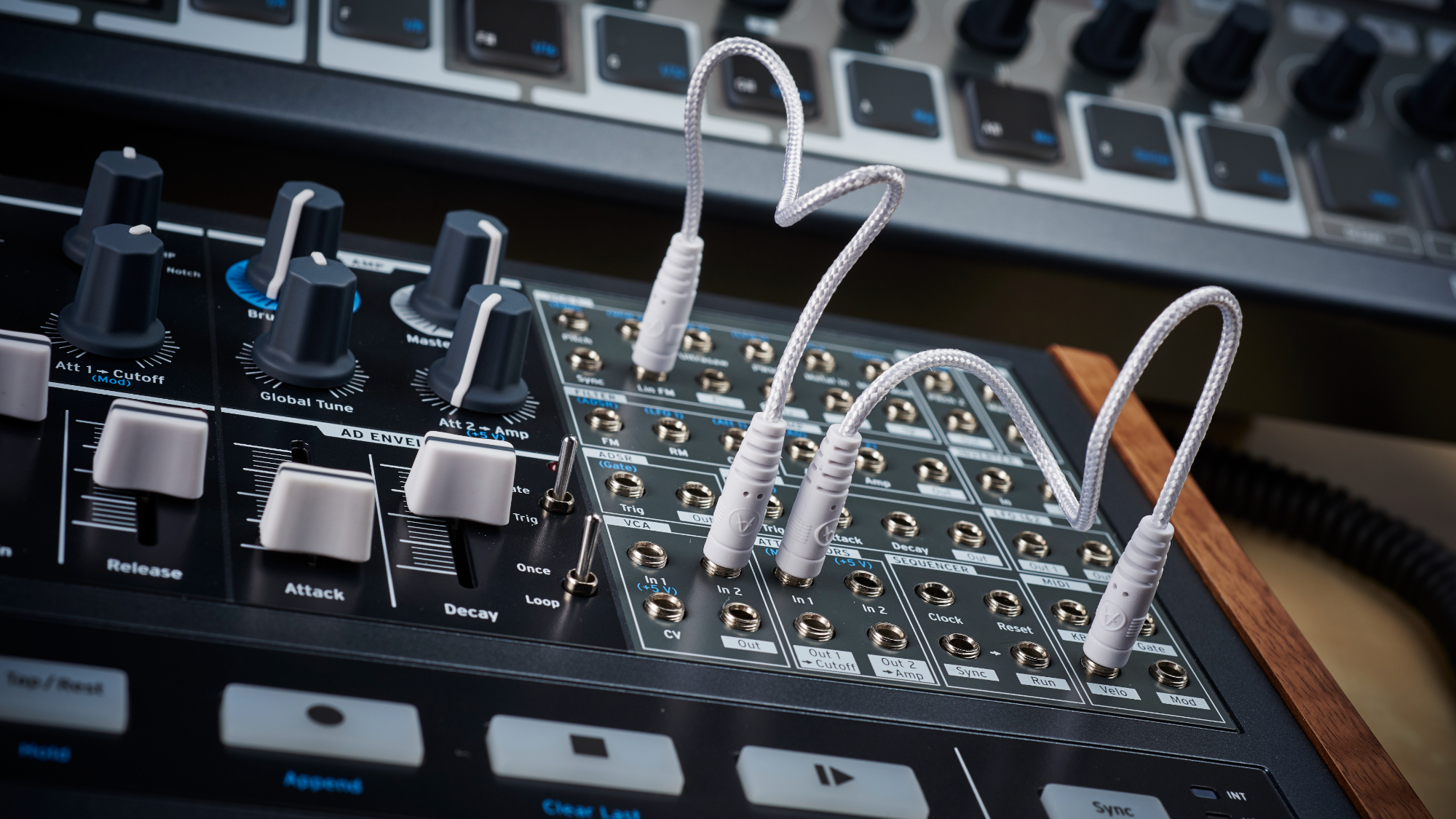
What connections can I expect my beginner synth to have?
Peer around the back of a synth and you should find a healthy number of connection ports. The critical ones for modern synths are power, headphone out, sound out (synths rarely have speakers), MIDI in/out and USB. Nice ones to have include CV/Gate, expression pedal input, trigger, and audio input.
USB will obviously enable you to connect a synth to your computer, perhaps just for updates but hopefully it will carry MIDI information and audio too. Some synths, such as the Roland System 8, have a partner software plugin that behaves exactly like the hardware but in your DAW. Once the synth is connected over USB it acts as a control surface and patches can be exchanged and backed-up between hardware and software versions. This is a marvellous learning environment for beginners.
MIDI will enable your synth to communicate with drum machines, sequencers and a whole plethora of other kit.
Why not just use VST/AU?
Why spend all this money on a piece of hardware when surely a software plugin is so much more convenient?
Hardware synths fell sharply out of fashion when musicians started making music on their computers, only to bounce back just a few years later. Today, hardware couldn't be more popular, despite the high quality and obvious advantages of softsynths.
Why? Playing a hardware synth is an immediate, tactile experience that demands you get stuck in with those knobs and dials. They're just more fun! We go into more depth on the hardware synth vs software synth debate here.
Find out more about how we test music gear and services at MusicRadar.
Related buyer's guides
- On a budget? Here are the best cheap synthesizers
- Go modular with our pick of the best semi-modular synths
- This is what we believe are the best synthesizers for all budgets
- These are the best piano VSTs
- Check out the best MIDI keyboards for all budgets
- Practice in silence with the best budget studio headphones
- We round-up the best electronic keyboards
- Just starting out? Here are the best keyboards for beginners
Want all the hottest music and gear news, reviews, deals, features and more, direct to your inbox? Sign up here.
When Simon's childhood classical guitar teacher boasted he 'enjoyed a challenge', the poor man had no idea how much he'd underestimated the scale of the task ahead. Despite Simon's lack of talent, the experience did spark a lifelong passion for music. His classical guitar was discarded for an electric, then a room full of electrics before Simon discovered the joys of keys. Against all odds, Simon somehow managed to blag a career as a fashion journalist, but he's now more suitably employed writing for MusicRadar and Guitar World. When not writing or playing, he can be found terrifying himself on his mountain bike.
